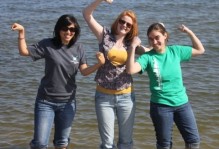Parts & The Whole
The other day, as I browsed through student blogs from colleges around the country, I noticed that, at some point, they all feature one type of post: a day in the life of the blogger. (Total side note, one of these posts described a 35-person class as “small.” I felt equal parts confusion and sympathy.) These posts detail the joys of rehearsal, practice, classes, lab work, study groups, working out, writing papers, and/or working on some fun and quirky hobby, before concluding with the same disclaimer: at College X or University of Y, there is no typical day.
Since I’m reading Alexander Pope for one of my British literature classes and he writes, in part, about the dangers of following the herd, I was wary to try this kind of post myself. Still, I gave it the old college try (I’ve been trying to delete that and come up with a less terrible and clumsy pun, but oh well). When I tried to document my day this past Monday, though, something didn’t feel right. I got all the basics: what I ate for breakfast, my morning review session in the library before class, sorority chapter meeting as an initiated sister for the first time, all the applications and meetings and coffee dates. Nothing was wrong, exactly. It was a pretty solid day, and most of it made it on paper. But all those separate pieces did not come together and 100% depict what Monday, February 2, had been. So I tried to write down everything for Tuesday too. And Wednesday.
At that point, I realized why I was struggling: it’s impossible to put a clear start or end time on anything in college. Timelines made so much sense in high school, but they just fall apart here, because everything overlaps. You’re not just a student and an athlete and a member of some clubs anymore; all the classes you take, causes you support, professors you admire, and ways you spend your time come together and make you a person.
So if you’re visiting campus and taking a tour, I encourage you to take a few moments before or after and explore on your own. You’ll get tons of good information on the tour, but exploring definitely helps you understand the whole. Sit on the steps at the top of the Sunken Garden when classes are changing—typically, at the twenty- and fifty-minute marks of an hour—or find a spot in an on-campus coffee shop, and just listen to what students are saying. Are they planning research? Going over a setlist for their band’s gig next weekend? Planning costumes for an upcoming philanthropy event? Debating a piece of breaking news? Something else that’s totally fair for an 18-22 year old to be thinking about? If you can, try a few different spots in a day, or even come back and visit again. Together, those conversations and voices, unique as they are, help fill in the gaps. Shadowing a current student or coming in for an interview, if you’re a hopeful student, are also great ways to get the experience! Not so great ways to get that experience: read a play-by-play of my day and take my word for it that William & Mary is a special place. My attempted timelines captured a lot of things, but missed even more: all the connections between classes, excitement at getting that email from the company I desperately want to intern with, the quiet thrill of piecing together a self-designed major class by class, the overwhelming affection that hits when I walk into Blair, home of my history classes. In other words, at the end of the day, a timeline doesn’t do a day at William & Mary any justice. The experience is so much greater than the sum of its parts.



No comments.
Comments are currently closed. Comments are closed on all posts older than one year, and for those in our archive.